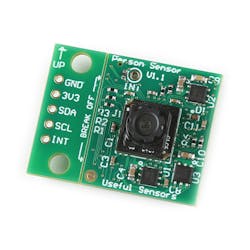Useful Trustworthy AI Sensors in Tiny Packages
Check out our Sensors Converge 2023 coverage. This video is part of the TechXchange: AI on the Edge.
Useful Sensors’ tagline is “AI you can trust.” The idea behind that is you can use artificial-intelligence/machine-learning (AI/ML) technology in devices without having to go to the cloud or sharing information. I spoke with Pete Warden, CEO of Useful Sensors, about the company's tiny AI platform that makes this possible (see video above). Their systems are designed whereby they don't require an internet connection and are difficult to tamper with.
Platforms like the Person Sensor is an inexpensive module (under $10 at Sparkfun) that uses an I2C interface to provide a host with advanced image-recognition support (Fig. 1). The module comes preprogrammed with algorithms to detect faces—and only needs 150 mW to perform this operation. The github project provides support for common development platforms like micro:bit, Arduino, and Raspberry Pi. The Tiny Code Reader is a QR-code scanner that utilizes a similar platform, but with different algorithms to handle QR codes.
Useful Sensors has other platforms like All-in-One-Box (Fig. 2), which provides voice recognition and natural language processing (NLP). The module is built around a Rockchip RK3588S system-on-chip (SoC). The SoC has four Arm Cortex-A76 and four Cortex-A55 processors in addition to a Rockchip neural processing unit (NPU) that utilizes a compressed large language model (LLM) file. Developers can take advantage of the software, which is distributed under GPL v3. Commercial licenses are available. It can also handle text-to-speech.
The ability to perform AI chores locally leads to better privacy and security. It also means these platforms don't require an internet connection. Too many devices, such as Alexa and Siri, depend on the cloud doing the work. This offers the advantage of an enormous, shared compute and database platform, but that only works with a low-latency, high-speed connection. Standalone AI platforms can still leverage the internet. However, because a connection isn't required, devices can continue to respond to users when there's no connection.
Check out more of our Sensors Converge 2023 coverage, and more videos/article in the TechXchange: AI on the Edge.
Links
About the Author
William G. Wong
Senior Content Director - Electronic Design and Microwaves & RF
I am Editor of Electronic Design focusing on embedded, software, and systems. As Senior Content Director, I also manage Microwaves & RF and I work with a great team of editors to provide engineers, programmers, developers and technical managers with interesting and useful articles and videos on a regular basis. Check out our free newsletters to see the latest content.
You can send press releases for new products for possible coverage on the website. I am also interested in receiving contributed articles for publishing on our website. Use our template and send to me along with a signed release form.
Check out my blog, AltEmbedded on Electronic Design, as well as his latest articles on this site that are listed below.
You can visit my social media via these links:
- AltEmbedded on Electronic Design
- Bill Wong on Facebook
- @AltEmbedded on Twitter
- Bill Wong on LinkedIn
I earned a Bachelor of Electrical Engineering at the Georgia Institute of Technology and a Masters in Computer Science from Rutgers University. I still do a bit of programming using everything from C and C++ to Rust and Ada/SPARK. I do a bit of PHP programming for Drupal websites. I have posted a few Drupal modules.
I still get a hand on software and electronic hardware. Some of this can be found on our Kit Close-Up video series. You can also see me on many of our TechXchange Talk videos. I am interested in a range of projects from robotics to artificial intelligence.


